Types of Bees that Nest in the Ground (with Pictures): Identification Guide
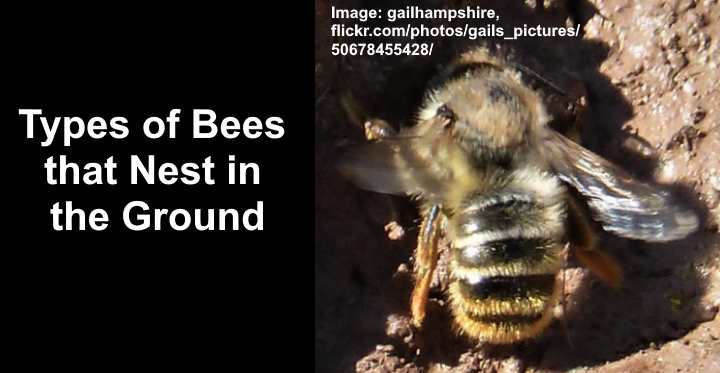
Many species of bees nest in the ground. You may notice bees buzzing around a hole in the soil. The chances are that these species are ground-nesting bees that live solitary lives, making their homes in the ground. Knowing how to identify bees that nest in the ground is vital. Some ground-nesting bees are harmless, whereas others are territorial and can become aggressive if you get too close.
Bees, like honey bees (Apis mellifera), are known for living in hives, large nests on trees, and large colonies. However, some bees, like bumble bees, miner bees, and sweat bees, prefer to dig burrows in the soil to create their homes. These bees have unique characteristics and behaviors that set them apart from their above-ground counterparts.
This article is a guide to the most common type of bees that nest in the ground. You will learn how to identify ground-nesting bees and where they are usually found. Whether you’re a nature enthusiast, a gardener, or simply curious about the different types of bees, you will learn to recognize these incredible flying insects.
What Are Ground-Nesting Bees?
Ground-nesting bees—like all bee species—belong to the insect order Hymenoptera. The bees dig tunnels or burrows in the ground or find abandoned holes of small mammals and rodents. The bees gather nectar and pollen for food and to feed their young. Ground-nesting bees can be black and yellow, black and white, metallic, blue, green, or purple.
Of the 20,000 species of bees worldwide, around 70 percent are bees that burrow tunnels to nest in the ground. Many types of ground-nesting bees are aggressive and will sting if you get too close to the nest. For example, Africanized bees and bumble bees get territorial.
Even though male ground-nesting bees are more aggressive than females, they are harmless. Male bees lack stingers. So, even though they may fly toward you and appear on the attack, they cannot sting you. The good news is that most ground-dwelling bees are harmless and not aggressive.
Types of Bees That Nest in the Ground: with Pictures and Descriptions
Let’s look in detail at the most common types of bees that nest underground.
Africanized Bee (Apis mellifera scutellata Lepeletier)
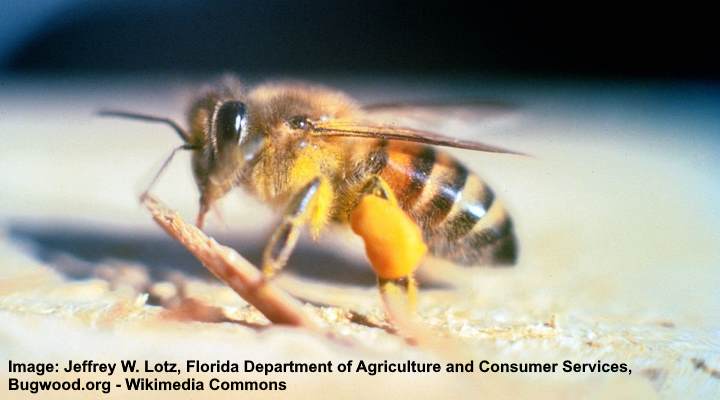
The Africanized bee is one of the most aggressive bee species that lives in the ground. Also called the “killer bee,” the feisty bee is identified by its golden-brown body with black stripes and covered in fine hairs. Their size, coloration, and behavior make them difficult to tell apart from honey bees.
African honey bees grow 0.40” to 0.60” (10 – 15 mm) long. They have well-defined abdominal stripes, typically black or dark brown and yellow. Because they resemble yellow jackets and honey bees, distinguishing the species is only possible by observing their behavior.
A characteristic of Africanized bees is their aggressive, stronger defensive response than honey bees. They tend to defend their nests with hundreds of bees. They also swarm more than Western bees and sting multiple times when threatened. They are capable of killing large mammals, including humans, due to the high number of stings.
Bumble Bee (Bombus)

An American bumble bee (Bombus pensylvanicus)
Bumble bees are the most easily recognized types of bees that burrow in the ground. There are over 250 species of bumble bees, mostly known for their large, fuzzy bodies with black and yellow stripes. The plump bees have stout bodies and a rounded abdomen tip, making them easy to tell apart from honey bees.
The largest type of bumble bee in North America is the Bombus pensylvanicus. The American bumble bee measures 0.55” to 0.71” (14 – 18 mm) long. The worker bees are typically black, furry creatures with yellow markings on their backs and body. All bumble bee species are important pollinators.
Although not regarded as aggressive, they may attack and sting if they feel threatened. Unlike honey bees, the female bees can sting multiple times because they have smooth stingers. However, when left alone, bumble bees are relatively docile flying insects.
Their sting can be painful, so it is best to observe them from a distance and avoid disturbing their nests.
Sweat Bees (Halictid Bees) (Halictidae)
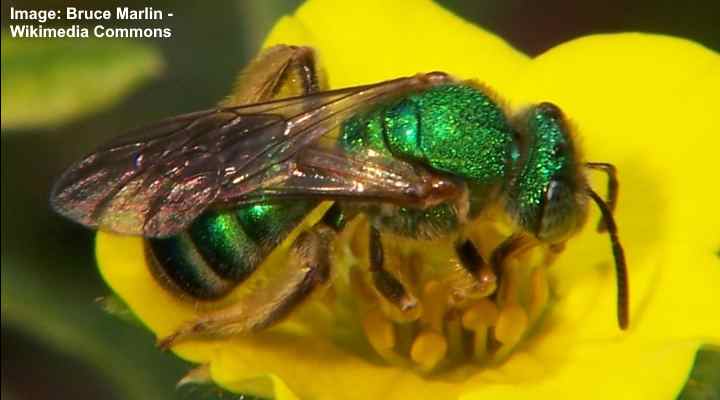
Different species of sweat bees vary in appearance, with some having green metallic body
Sweat bees in the order Halictidae are the most common ground-dwelling bees. These non-aggressive Halictid bees vary in appearance. However, most are identified by their slender bodies, usually black or dark brown and metallic green, purple, or blue colorations. Some species have characteristic black and yellow bands on their abdomens.
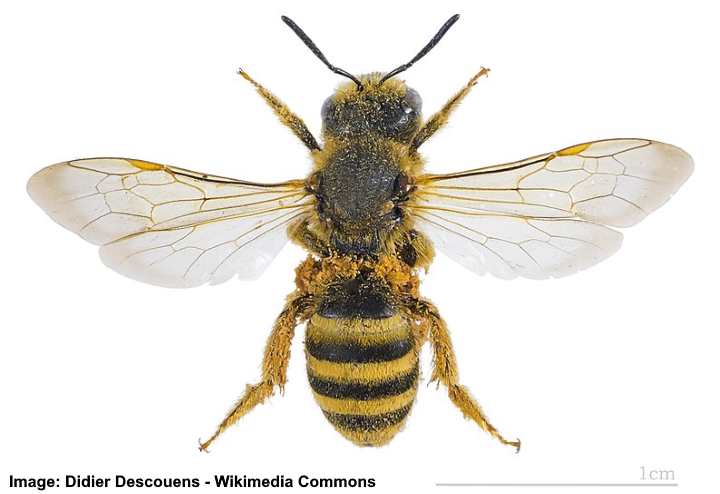
The great banded furrow bee (Halictus scabiosae) is a sweat bee with black and yellow coloration
Most halictid sweat bees nest underground. They typically build a collection of underground cells to lay eggs and raise their young. Because they don’t exhibit aggressive behavior and are important pollinators, it’s good to encourage sweat bees to your yard by planting bee-friendly flowering shrubs and wildflowers.
A characteristic of sweat bees is their attraction to perspiration. They use sweat for moisture and salts. However, they mostly eat nectar and pollen and are vital pollinators.
Sweat Bees (Dialictus)
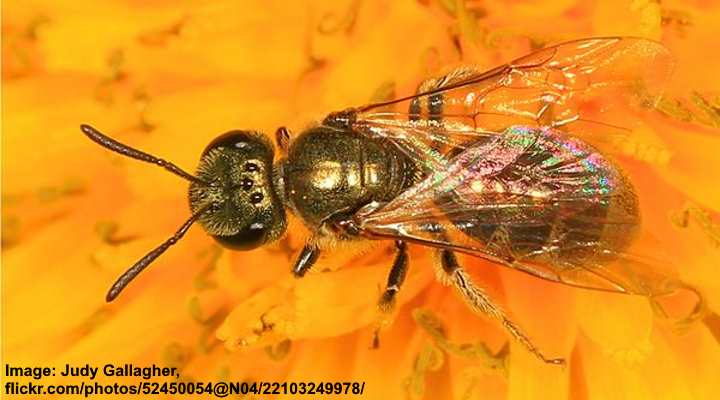
Lasioglossum subgenus dialictus
Sweat bees in the genus Lasioglossum are small, metallic-colored, non-aggressive bees common throughout North America. The small bees are typically black, metallic green, or blue in color. Some species may have bands of yellow or white on their bodies. Sweat bees are relatively small, measuring about 0.11” to 0.31” (3 – 8 mm) long.
Sweat bees are generally not aggressive and rarely sting unless directly provoked or threatened. The solitary female sweat bees create burrows in the ground to build nests and care for their young. Some species of Lasioglossum sweat bees are social creatures and live in small colonies.
Miner Bee (Andrena)

Ashy mining bee (Andrena cineraria) nest
Most miner bees nest underground and are solitary insects that prefer sandy soils. There are over 1,500 species of miner bees, most of which measure between 3.1” to 0.67” (8 – 17 mm) long. General identifying features are their slender black bodies covered in white to tan hairs.
A characteristic of ground-dwelling miner bees is their pollen collection. Like most bees, they carry pollen on their hairy legs. However, many miner bees also have pollen baskets on their thorax. A unique identifying feature of miner bees is the velvety area between their compound eyes.
Calliopsis Mining Bees (Calliopsis)
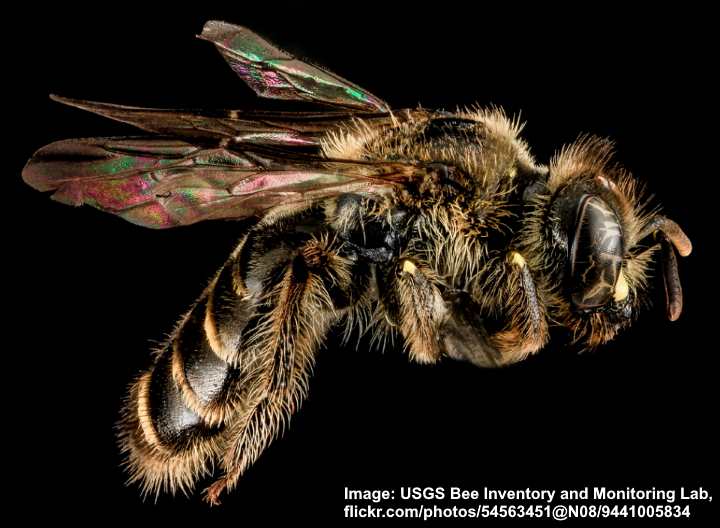
The eastern miner bee (Calliopsis andreniformis)
All types of bees in the genus Calliopsis are solitary bees that nest in the ground. The mining bees are identified by their yellow and black stripes, broad heads, and dark wings. These non-aggressive bees have narrow wings compared to other bee species. The females are solitary ground-nesting bees.
Calliopsis mining bees are among the most common bees in Eastern North America. For example, the eastern miner bee (Calliopsis andreniformis) is a small black ground-dwelling bee that lives in small sandy burrows. It measures 0.27” (7 mm) long and has thin yellowish-tan stripes on its abdomen and large compound eyes.
Cuckoo Bumble Bees (Psithyrus)

A cuckoo bumblebee Bombus insularis
Cuckoo bumble bees are a group of stout, fuzzy bees that live in underground tunnels and look like regular bumble bees. They don’t collect pollen or create a worker caste because they steal the food and nests of other bumble bees.
For example, the indiscriminate cuckoo bumblebee (Bombus insularis) looks like a common bumble bee. It’s identified by its black body with bands of yellow hairs and hairy black legs. This native parasitic bee measures 0.62” to 0.74” (16 – 19 mm) long.
Unlike other bumble bees, cuckoo bumble bees do not build nests or collect food. Instead, they invade the nests of other bumble bee species and lay their eggs there. They are typically larger and have more vibrant colors than the bumble bees they parasitize.
Yellow-Legged Nomad Bee (Nomada succincta)
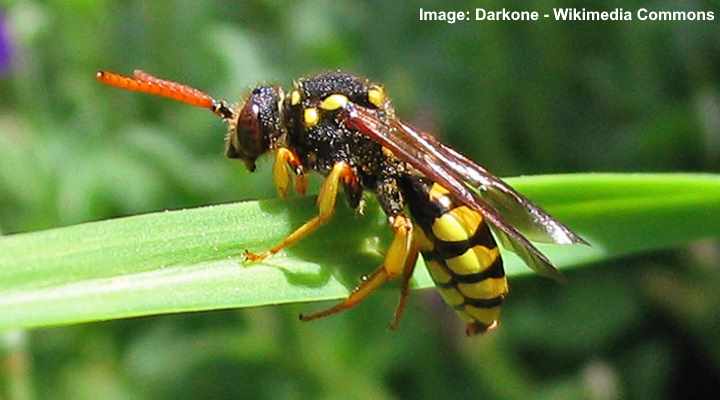
The yellow-legged nomad bee is a small black and yellow bee that buries in the ground to create a nest. The ground-dwelling wasp-like bee is identified by its tear-shaped yellow abdomen with black bands, yellow legs, and brownish wings. Preferring to live in underground burrows, the yellow-legged nomad bee measures 0.31” to 0.40” (8 – 10 mm) long.
Nomad cuckoo bees are classified as kleptoparasites and don’t collect pollen. Instead, the females lay their eggs in the nests of other bee species and steal the pollen other bees have collected. They use this to feed themselves and their offspring. Cuckoo bees are often mistaken for wasps or flies due to their dark color and lack of pollen-carrying structures.
Long-Horned Bee (Eucera longicornis)
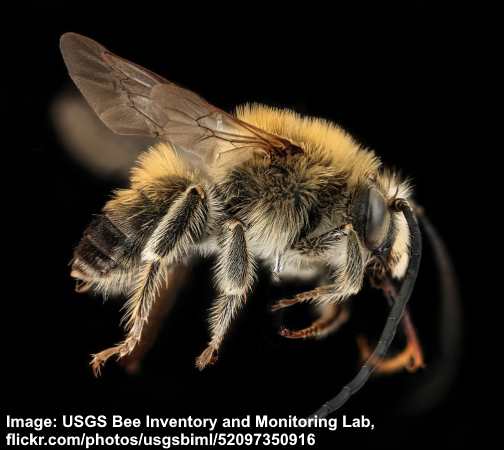
The long-horned bee prefers to nest in subterranean burrows. This ground-dwelling bee species is identified by its extraordinary long antennae—hence its name, long-horned bee. These medium-sized bees measure about 0.51” (13 mm) long. They have a robust, fuzzy yellow-orange body with black and yellow markings and transparent wings.
Long-horned bees are solitary, docile insects and create ground nests in clay soils. However, the bees tend to be active in coastal habitats and grassy woodlands. They are non-aggressive bees and will only sting when they feel threatened. These bees use their long antennae to detect scents and locate flowers for feeding on nectar and collecting pollen.
Digger Bees (Anthophorini)
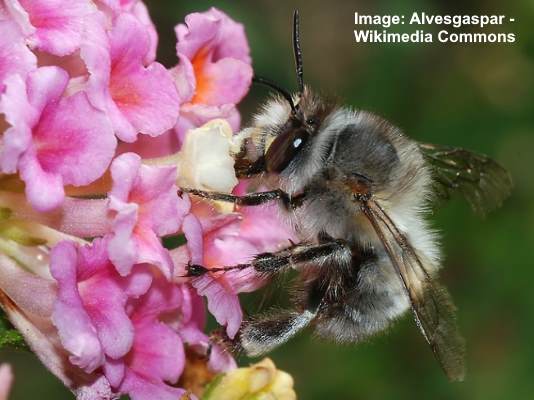
A digger bee (Anthophora plumipes)
Digger bees are a group of solitary bees known for digging nests in the ground. Most bees in the tribe Anthophorini are large black or dark brown bees covered in soft grayish-white hairs. Some bees have banded abdomens with metallic blue colors.
Digger bees have stout bodies measuring 1.18” (30 mm) long on average. You can notice digger bee activity by holes measuring 0.5” (13 mm) surrounded by mounds of soil on bare patches of lawns. There is usually a lot of bee activity near the holes in summer.
Orchid Bees (Euglossini)
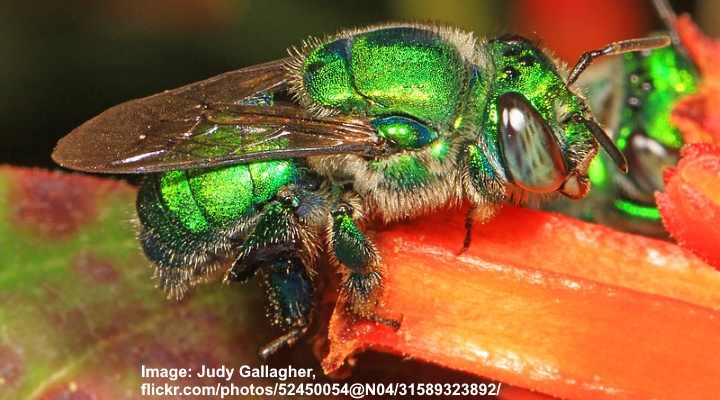
The green orchid bee (Euglossa dilemma)
Orchid bees are a group of colorful bees that build nests in the soil. The easily identifiable bees have vibrant metallic colors, ranging from green and blue to purple and gold. Other identifiable features are their short, segmented antennae, transparent wings, and patches of fine grayish setae (hairs).
The males of this species are more brightly colored than the females, and they use their colors to attract mates. Orchid bees are important in pollinating orchids, as they collect and transfer pollen while foraging for nectar. These bees are often considered indicators of the health of tropical forests, as they rely on a diverse range of flowers for their survival.
One of the most common ground-dwelling orchard bees is the green orchid bee (Euglossa dilemma). This solitary bee measures 0.51” (13 mm) long and has a metallic green body. Despite the female ground-nesting bees having stingers, they are fairly timid and rarely sting.
Stingless Bees (Meliponini)
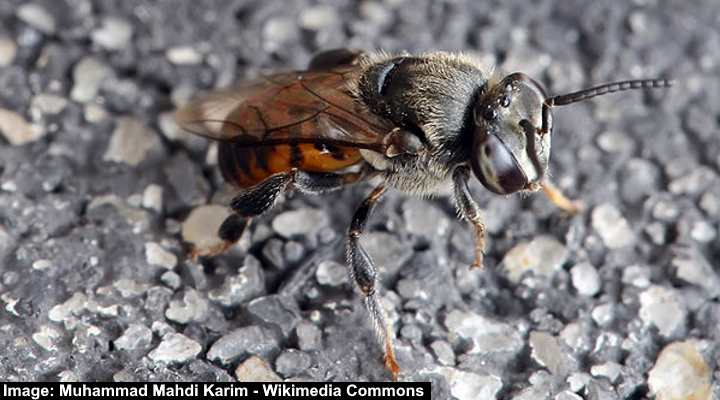
A Meliponula ferruginea stingless bee
Stingless bees are small, dark-colored bees that prefer living in underground cavities, hollow tree trunks, termite nests, or holes in tree branches. Also known as stingless honey bees or meliponines, the bees—males and females—lack a stinger. They typically measure 0.2” to 0.4” (5 to 10 mm) in length.
Stingless bees are typically found in tropical and subtropical regions of North America. Their unique behavior means they bite and spray formic acid as a defense mechanism. They are social insects living in colonies with queen and worker bees.
Stingless bees also produce honey in tropical regions. However, their honey production is much lower compared to honey bees. But their honey has a unique flavor and medicinal properties.
Plaster Bees (Colletes)
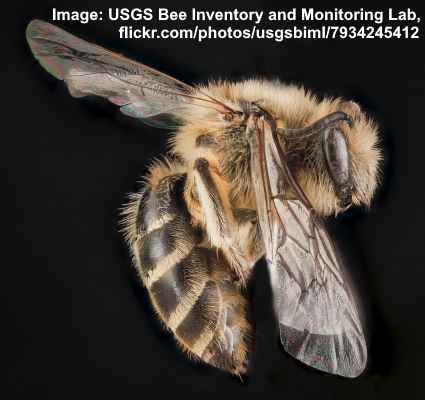
A plasterer bee (Colletes inaequalis)
Plaster bees are a type of solitary bee that builds its nests in underground burrows. These soil-nesting bees are typically medium-sized with a black or dark brown body with well-defined bands of yellow or white hair on their abdomens. They range in size—from a few millimeters long to about the size of a bumble bee.
Their unique characteristic is how they line underground nest walls with a secretion, just like a plasterer, to create a cellophane-like lining.
The most common species of plaster bee — Colletes inaequalis — is a black and tan-colored bee with a black abdomen and tan stripes. These ground nesting bees can be identified by their fuzzy tan-colored head, pair of translucent wings, heart-shaped face, large compound eyes, and two segmented antennae. Plaster bees typically measure 0.5” (13 mm) long and are active between March and July.
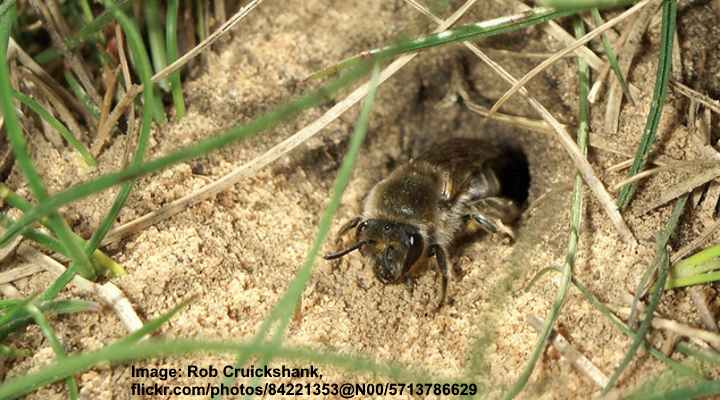
A ground bee nest
Alkali Bee (Nomia melanderi)
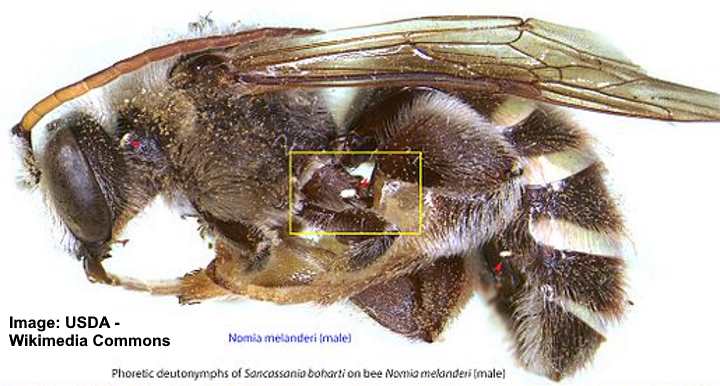
The alkali bee is a small dark bee that builds its nest in the ground. Identifying features of the solitary bee are its distinctive white to grayish bands on its abdomen, with a metallic sheen. The ground-dwelling bee is about two-thirds the size of a honey bee.
The alkali bee is native to western North America and is commonly found in arid habitats. Although solitary, they create underground nests in high densities. The female bees create a tunnel and separate cells in the burrow to deposit one to two eggs daily.
Alkali bees are active during the spring and summer. They can be identified by their small size, black color, and metallic appearance.
Ptilothrix
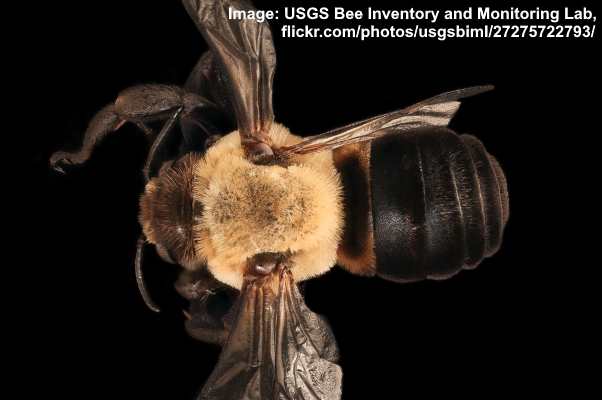
The hibiscus bee / eastern digger bee (Ptilothrix bombiformis)
Ptilothrix is a genus of solitary, ground-nesting bees that resemble bumble bees. Bees in the genus Ptilothrix are common throughout North America. The hairy brown bees can range in size from 0.28” to 0.60” (7 – 15 mm).
Stenotritidae
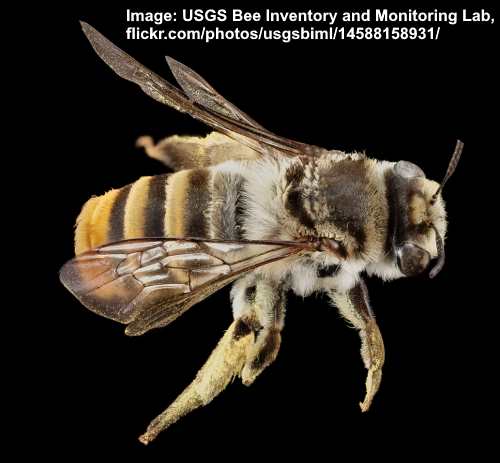
Stenotritus pubescens
Ground-dwelling bees in the family Stenotritidae are large, hairy, fast-flying bees that make burrows in the ground for nesting. The tunneling bees have yellow, black, and white-banded abdomens, large brown compound eyes, and a thorax covered in grayish setae. The bees are native to Australia and measure 0.47” to 0.60” (12 – 15 mm) long.
Mason Bee (Osmia)
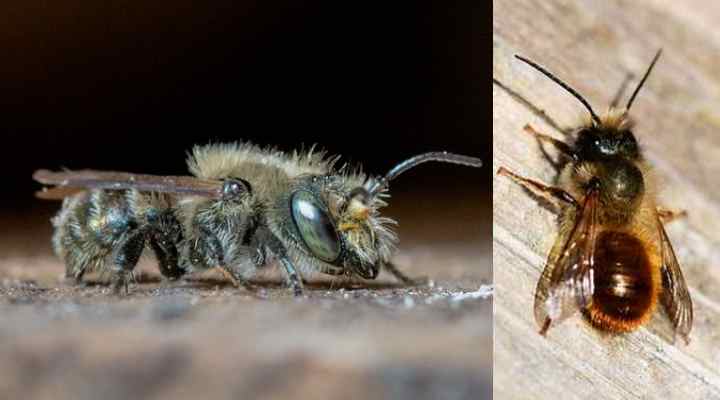
Many mason bees have metallic blue-green bodies (left picture). Some mason bees such as the red mason bee (Osmia bicornis) can have black or maroon colors (right picture)
Mason bees are small, solitary bees that frequently use cavities to burrow in the ground for nesting. Bees in the Osmia genus are typically black or dark metallic blue or green colors. One species is a rust-red color. The bees have a stocky, robust body shape, tufts of brownish hair, and long black antennae.
Unlike honeybees, mason bees do not produce honey and are not aggressive. They are excellent pollinators for fruit trees, flowers, and other plants due to the unique way they transport pollen.
Mason bees typically measure 0.37” to 0.62” (9.5 – 15 mm). They are ground-dwelling, docile bees who get their name from their habit of using mud or clay to construct their nests in small holes or crevices, such as in hollow reeds or wood. They often create nests in the ground for their offspring.
Leaf Cutting Bees (Megachilidae)
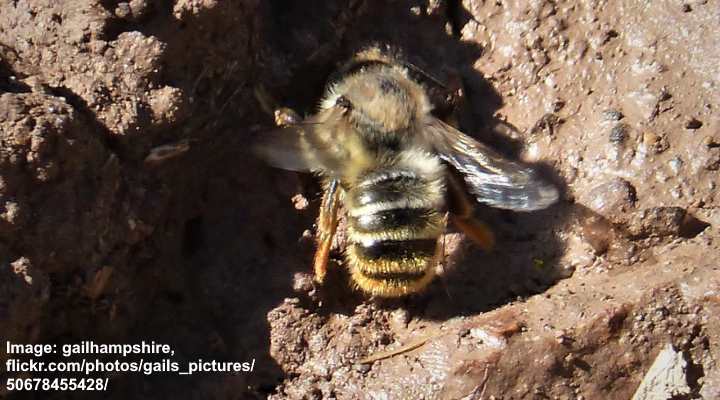
Leaf-cutting bees often construct nests in soil, rotting wood, and plant stems. The medium-sized solitary bees are identified by their vibrant colors, banded abdomens, and long faces. They typically measure 0.20” to 0.94” (5 – 24 mm) in length. They are excellent pollinators by transferring pollen on the hairy underside of their abdomens.
Cavity nesting leafcutter bees have a unique behavior of cutting circular pieces of leaves to construct overground or surface nests.
Related articles:
